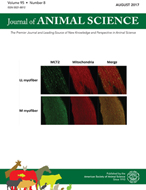-
Views
-
Cite
Cite
M. Nii, T. Hayashi, S. Mikawa, F. Tani, A. Niki, N. Mori, Y. Uchida, N. Fujishima-Kanaya, M. Komatsu, T. Awata, Quantitative trait loci mapping for meat quality and muscle fiber traits in a Japanese wild boar × Large White intercross, Journal of Animal Science, Volume 83, Issue 2, February 2005, Pages 308–315, https://doi.org/10.2527/2005.832308x
Close - Share Icon Share
ABSTRACT
Three generations of a swine family produced by crossing a Japanese wild boar and three Large White female pigs were used to map QTL for various production traits. Here we report the results of QTL analyses for skeletal muscle fiber composition and meat quality traits based on phenotypic data of 353 F2 animals and genotypic data of 225 markers covering almost the entire pig genome for all of the F2 animals as well as their F1 parents and F0 grandparents. The results of a genome scan using least squares regression interval mapping provided evidence that QTL (<1% genome-wise error rate) affected the proportion of the number of type IIA muscle fibers on SSC2, the number of type IIB on SSC14, the relative area (RA) of type I on SSCX, the RA of type IIA on SSC6, the RA of type IIB on SSC6 and SSC14, the Minolta a* values of loin on SSC4 and SSC6, the Minolta b* value of loin on SSC15, and the hematin content of the LM on SSC6. Quantitative trait loci (<5% genome-wise error rate) were found for the number of type I on SSC1, SSC14, and SSCX, for the number of type IIA on SSC14, for the number of type IIB on SSC2, for the RA of type IIA on SSC2, for the Minolta b* value of loin on SSC3, for the pH of loin on SSC15, and for the i.m. fat content on SSC15. Twenty-four QTL were detected for 11 traits at the 5% genome-wise level. Some traits were associated with each other, so the 24 QTL were located on 11 genomic regions. In five QTL located on SSC2, SSC6, and SSC14, each wild boar allele had the effect of increasing types I and IIA muscle fibers and decreasing type IIB muscle fibers. These effects are expected to improve meat quality.





